Edge Sorting, 101
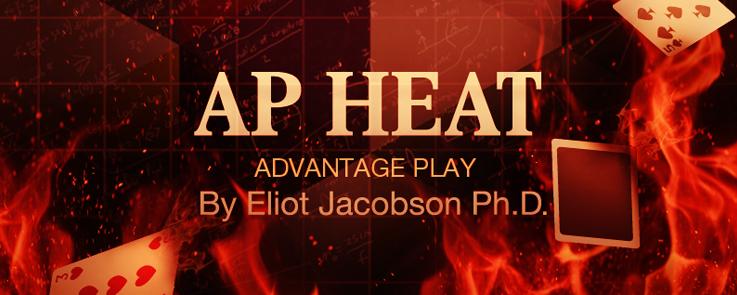
Edge sorting is a method of advantage play that uses natural irregularities in the cut on the backs of cards to be able to identify certain groups of cards. By being able to identify critical cards, APs are able to improve their betting and playing decisions. This method of advantage play is not new; APs have been using it to beat the house for at least two decades. The advantages that edge sorting can produce are significant and enduring. The games targeted range from blackjack and baccarat to Caribbean Stud and Three Card Poker. Casinos around the world have been hard hit by this method. And the fix is trivial.
Abram Alexander, in his book “Advanced Tactics in Casino Advantage Play” (available only as a Kindle e-book), wrote,
“One of the most closely-guarded secrets in the upper echelons of casino advantage play is the practice of card sorting, known as “the turn” … The technique is predicated on the imperfections in the manufacturing process of casino playing cards. The backs of the cards, which generally contain some sort of repeating diamond or geometrical pattern, are often asymmetrical. If examined closely, it will be revealed that the top and bottom or right and left edges of the cards are not identical … My own experience is limited, having only played on my own, and only in three casinos (The Palms, The Orleans, and the Barbary Coast) … This technique is best practiced with a team that can lock up the entire table and, in fact, I have on more than a few occasions come into a casino to see a veritable who’s who of advantage players working in concert to make it happen.”
To understand how edge sorting works, we have to examine the backs of a few common playing cards. The following two designs show asymmetries along the right and left edges. Note the full diamond shapes along the left edge and the half-diamond shapes along the right edges.
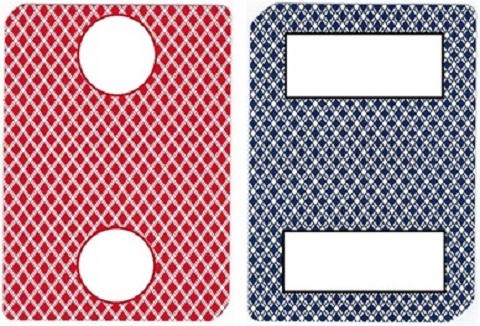
The following images show that cards with faded edges can also give rise to asymmetries. Note the difference in the width of the bleached borders in the following images. The image on the left has a top/bottom edge asymmetry. The image on the right has a left/right edge asymmetry.
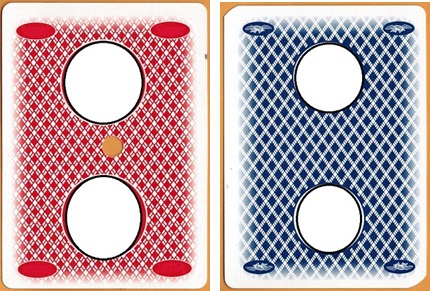
The games that are vulnerable are those for which there is a strategically important group of cards, which is nearly every game. During the play of the game, the AP (or team of APs) turns the cards so as to be able to distinguish the important cards from the other cards. For example, using a card with a left/right diamond asymmetry, the AP may align the cards so that full diamonds along the left edge corresponds to an important card, and half-diamonds on the left edge corresponds to the other cards. The AP attempts to turn every card in the deck or shoe to identify its group. After the cards are sorted, the AP then observes the appropriate edge during the play of a hand. By knowing the card’s group, the AP makes a decision that shifts the edge in his favor. That edge will persist as long as the cards remain aligned.
For example, in baccarat the important cards are {6, 7, 8, 9}. If the AP knows that the first card to be dealt is from this group, then he makes a wager on the Player hand. If the first card is not in this group, then the AP wagers on the Banker hand. This simple strategy is enough to gain an edge of 6.765% over the house (see this blog post and this blog post).
Here is an example of how this sorting may look in practice for baccarat:
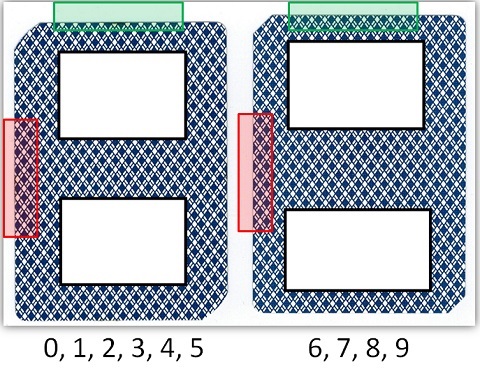
Here is a picture of a shoe, showing how it may be possible to read a card before it is played:
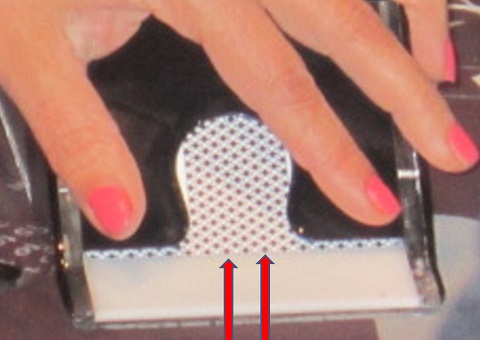
Here is a pitch game where an edge can be observed:
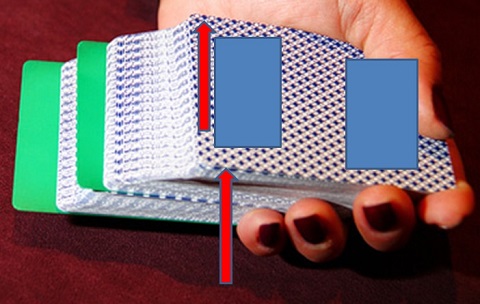
Here is the proprietary game Three Card Poker, where the edge of each dealer card can be observed:
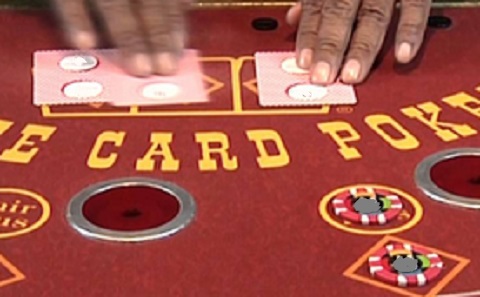
Here is a video that explains edge sorting:
;
Determining the two groups of cards is usually fairly obvious. The following table gives some games, the key card group for each game and the possible edge the AP can get:
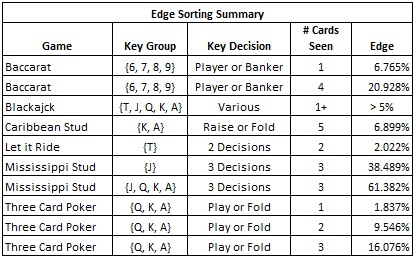
[On June 13, 2014, I posted an update to my results on edge sorting in baccarat. I showed that using the High group {4, 5, 6, 7, 8, 9}, the edge sorter obtains a 30.2912% edge over the house if he sees all four cards face down before making his wager.]
For blackjack, in particular, there are many ways that sorting can assist the AP. Using edge sorting, the AP may know significant information about one or more of the following:
- The dealer’s hole-card.
- The next card to be dealt from the top of the deck.
- The first card to be dealt in the next round.
For example, knowing that next card is not a face card, the player will hit all 12-valued hands. The player will also have near perfect information for his insurance bets. This information can also help the player decide his initial wager if he is seated at first base. Knowing the first card is an Ace or Ten-valued card gives the AP an edge of more than 18% over the house; he will make a much larger wager in this case.
The death knell for edge sorting is trivial: include a “turn” in the shuffle procedure. A turn is when the cards are divided into two stacks, and one of the stacks is rotated 180 degrees with respect to the other. The turn should occur mid-shuffle (after a riffle), in a hand shuffled game. In a game where an automatic shuffling machine is used, a turn should be performed just before the cards are inserted into the shuffle machine.
Alexander wrote,
“Any advantage player who sees this procedure in place in a casino should have lowered expectations for successfully putting a turn play on that venue… This susceptibility to a simple counter-measure is precisely why the turn has been kept under wraps for so long.”
For edge sorting to work in a casino, the AP needs all of the following:
- Cards that have a clearly visible asymmetry.
- A game where one or more card backs can be viewed before a critical decision is made.
- A fixed dealing and play procedure so that when the cards are collected from the players, their orientation can be consistently determined.
- A shuffle procedure that does not include a turn.
- The ability to lock up seats at the table so that civilians don’t interfere with the sort.
- Ignorance of the method by on-site table games staff and surveillance.
I first discovered that a majority of playing cards had asymmetric card back designs in 2002. I remember demonstrating what might be possible to a few of my AP friends. I sorted a couple of cards and could suddenly pick out the Aces and other key cards. I never considered actually trying to execute an edge sorting scheme in a live casino. In that sense, I have no practical experience using this method. Even so, I first wrote about the possibility of edge sorting back in 2005. I first encountered its use in 2007.
When Phil Ivey beat Crockford’s Casino out of more than twelve million ($12,000,000) dollars in October, 2012, this method hit the mainstream. Because of the publicity of Ivey vs. Crockfords, casinos internationally have been hit hard by would-be edge sorting teams. In particular, Three Card Poker has become a big target, giving the AP an edge easily in excess of 15% over the house.
Edge sorting in many ways resembles card marking, which is an illegal activity. Edge sorting looks like a duck and quacks like a duck; the edge sorting team proceeds tactically in every way like a card-marking team. However, an edge sorter is not a duck: he is not marking cards and he is not cheating. Edge sorting is a method that takes advantage of the equipment and procedures a casino uses together with the casino’s lack of awareness. Edge sorters take advantage of cards that come pre-marked by the card manufacturer. Cheaters mark cards.
The playing card should be at the front of the line for game protection. In my opinion, card manufactures should get their collective acts together and stop selling defective products to their clients. In the mean time, casinos absolutely must include a turn in the shuffle procedure for every card game.
Note added, June 2, 2015.
To bring you up to date:
Phil Ivey and Cheung Sun brought edge sorting to the attention of millions when Ivey admitted he edge sorted with Sun at Crockfords Casino in London in 2012. As you surely know, in October, 2014, Ivey lost his lawsuit to recoup his $12M in winnings from Crockfords. Subsequently, Ivey was sued by the Borgota casino for $9M. Ivey was determined to have edge sorted at the Borgata, and $9M is the amount Ivey and Sun won during the period they employed this technique. That case is ongoing. On June 2, 2015, Cheung Sun lost her bid to recoup $1.1M confiscated from her by Foxwoods Casino in 2011, after it was determined she used edge sorting.
Edge sorting isn't doing very well in the courts these days. Maybe a better way to say this is that Phil Ivey and Cheung Sun aren't doing very well in the courts. I know of many instances of edge sorting that were not prosecuted in civil court. The APs got to keep their winnings without a legal battle. But, when the amount won gets into the "millions" range, people get pretty serious about these things.


